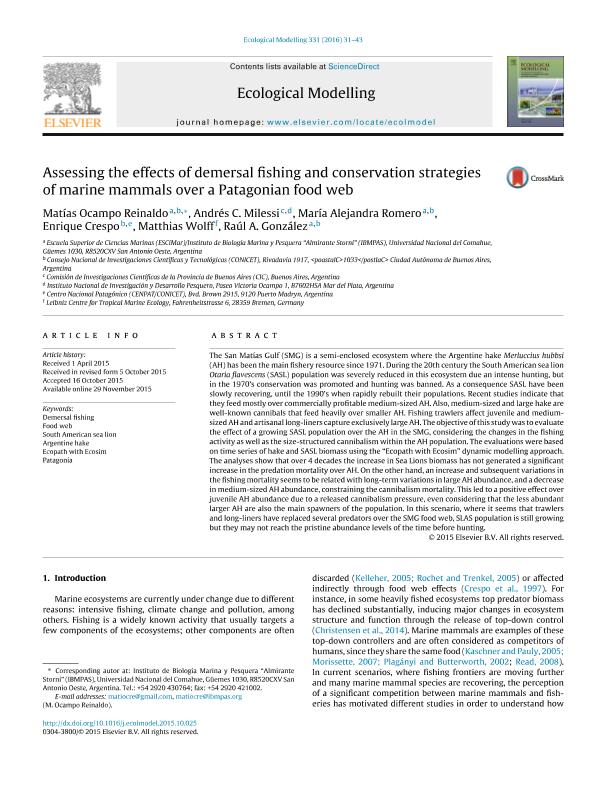Artículo
Assessing the effects of demersal fishing and conservation strategies of marine mammals over a Patagonian food web
Ocampo Reinaldo, Matías ; Milessi Millan, Andres Conrado
; Milessi Millan, Andres Conrado ; Romero, Maria Alejandra
; Romero, Maria Alejandra ; Crespo, Enrique Alberto
; Crespo, Enrique Alberto ; Wolff, Matthias; González, Raul Alberto Candido
; Wolff, Matthias; González, Raul Alberto Candido
 ; Milessi Millan, Andres Conrado
; Milessi Millan, Andres Conrado ; Romero, Maria Alejandra
; Romero, Maria Alejandra ; Crespo, Enrique Alberto
; Crespo, Enrique Alberto ; Wolff, Matthias; González, Raul Alberto Candido
; Wolff, Matthias; González, Raul Alberto Candido
Fecha de publicación:
10/07/2016
Editorial:
Elsevier Science
Revista:
Ecological Modelling
ISSN:
0304-3800
Idioma:
Inglés
Tipo de recurso:
Artículo publicado
Clasificación temática:
Resumen
The San Matías Gulf (SMG) is a semi-enclosed ecosystem where the Argentine hake Merluccius hubbsi (AH) has been the main fishery resource since 1971. During the 20th century the South American sea lion Otaria flavescens (SASL) population was severely reduced in this ecosystem due an intense hunting, but in the 1970's conservation was promoted and hunting was banned. As a consequence SASL have been slowly recovering, until the 1990's when rapidly rebuilt their populations. Recent studies indicate that they feed mostly over commercially profitable medium-sized AH. Also, medium-sized and large hake are well-known cannibals that feed heavily over smaller AH. Fishing trawlers affect juvenile and medium-sized AH and artisanal long-liners capture exclusively large AH. The objective of this study was to evaluate the effect of a growing SASL population over the AH in the SMG, considering the changes in the fishing activity as well as the size-structured cannibalism within the AH population. The evaluations were based on time series of hake and SASL biomass using the "Ecopath with Ecosim" dynamic modelling approach. The analyses show that over 4 decades the increase in Sea Lions biomass has not generated a significant increase in the predation mortality over AH. On the other hand, an increase and subsequent variations in the fishing mortality seems to be related with long-term variations in large AH abundance, and a decrease in medium-sized AH abundance, constraining the cannibalism mortality. This led to a positive effect over juvenile AH abundance due to a released cannibalism pressure, even considering that the less abundant larger AH are also the main spawners of the population. In this scenario, where it seems that trawlers and long-liners have replaced several predators over the SMG food web, SLAS population is still growing but they may not reach the pristine abundance levels of the time before hunting.
Archivos asociados
Licencia
Identificadores
Colecciones
Articulos(CCT - PATAGONIA NORTE)
Articulos de CTRO.CIENTIFICO TECNOL.CONICET - PATAGONIA NORTE
Articulos de CTRO.CIENTIFICO TECNOL.CONICET - PATAGONIA NORTE
Articulos(CESIMAR)
Articulos de CENTRO PARA EL ESTUDIO DE SISTEMAS MARINOS
Articulos de CENTRO PARA EL ESTUDIO DE SISTEMAS MARINOS
Citación
Ocampo Reinaldo, Matías; Milessi Millan, Andres Conrado; Romero, Maria Alejandra; Crespo, Enrique Alberto; Wolff, Matthias; et al.; Assessing the effects of demersal fishing and conservation strategies of marine mammals over a Patagonian food web; Elsevier Science; Ecological Modelling; 331; 10-7-2016; 31-43
Compartir
Altmétricas



